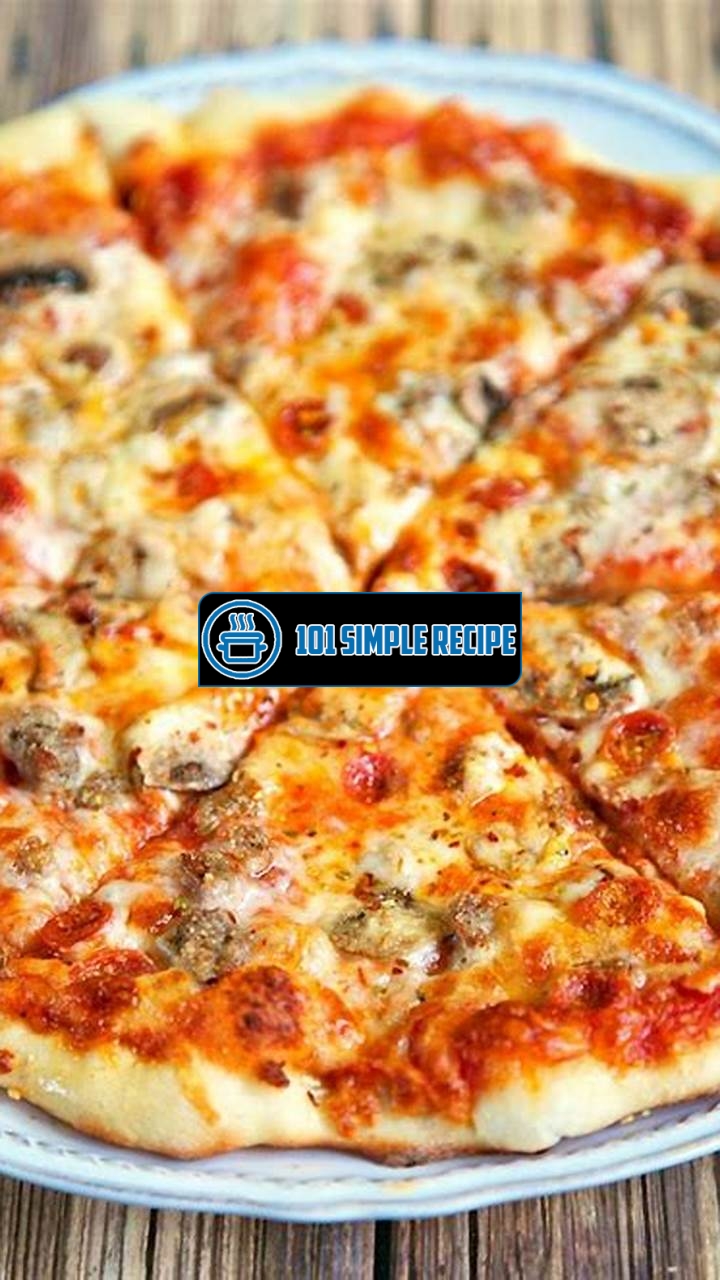Are you ready to discover the secret to creating irresistible New York pizza dough? Look no further because we’ve got you covered! The art of making authentic New York-style pizza dough is a cherished tradition that has been passed down through generations. This article will take you on a mouthwatering journey where you will learn the key ingredients, techniques, and tips to achieve that perfect chewy, thin, and crispy crust that New York-style pizzas are renowned for. So put on your apron and get ready to become a pizza master! ✨

Understanding the New York Pizza Dough
When it comes to pizza, New York City is legendary for its delicious slices. One of the key factors that sets New York pizza apart from the rest is its unmistakable dough. Understanding the characteristics and techniques behind New York pizza dough is essential for recreating that authentic taste at home. In this article, we will delve into the secrets of New York pizza dough that make it so irresistible.
The Signature Chewy Texture
One of the defining features of New York pizza dough is its signature chewy texture. As you take a bite, you’ll notice that the dough has an enjoyable resistance and elasticity. Its chewiness allows for a satisfying mouthfeel that keeps you coming back for more.
To achieve the perfect chew, New York pizza dough relies on high gluten content. Gluten, a protein found in wheat, gives the dough its stretchy and chewy properties. The choice of flour and the kneading process both play important roles in developing gluten. New York pizza dough typically uses high-protein bread flour, which contains more gluten than all-purpose flour.
Tip: To enhance the dough’s chewiness, consider using bread flour instead of all-purpose flour.
The Perfect Combination of Flours
New York pizza dough is also distinguished by the combination of flours used in its preparation. While bread flour is the star ingredient, a small amount of lower protein flour is often added to achieve the desired texture. This blend of flours allows for the perfect balance between chewiness and lightness.
A common practice is to incorporate a portion of cake flour into the dough recipe. Cake flour is lower in protein compared to bread flour, which helps to create a softer and more tender crust. This combination of flours results in a pizza dough that strikes the ideal balance between a chewy interior and a crisp exterior.
Tip: Try using a blend of bread flour and cake flour to create that New York pizza dough texture.
The Secret Ingredient: Cold Fermentation
While high-quality ingredients and precise measurements are important, there is one secret ingredient that truly elevates New York pizza dough: cold fermentation. This process involves allowing the dough to rise and develop its flavors in the refrigerator for an extended period.
Cold fermentation is what gives New York pizza dough its depth of flavor and distinctive texture. During this slow rise, the yeast in the dough continues to work, resulting in a more complex and nuanced taste. The cold temperature inhibits the yeast’s activity, making the dough develop its flavor more gradually. Additionally, the longer fermentation allows for better gluten development, enhancing the texture of the dough.
Tip: For the best results, refrigerate your dough for at least 24 hours to achieve that authentic New York pizza flavor.
In conclusion, New York pizza dough is truly a work of art. Its chewy texture, the perfect combination of flours, and the secret ingredient of cold fermentation all contribute to its irresistibility. By following these techniques and understanding the key characteristics of New York pizza dough, you can recreate that iconic flavor in your own kitchen. So, grab your apron, get your dough ingredients ready, and start rolling out that perfect New York-style pizza!
Choosing the Right Flour
In order to achieve the perfect New York pizza dough, choosing the right flour is crucial. The type of flour you use will greatly affect the texture and taste of your pizza crust. With so many options available, it can be overwhelming to decide which one is best. But fear not, we’re here to guide you through the process.
- All-purpose flour: This is the most common type of flour used in pizza dough recipes. It’s a versatile option that works well in a variety of recipes, including pizza. All-purpose flour has a moderate protein content, which gives the dough a good structure and a slightly chewy texture.
- Bread flour: Bread flour is high in protein and is commonly used in bread-making. It has a higher gluten content compared to all-purpose flour, which results in a chewier and more elastic crust. If you prefer a crust with a hearty texture, bread flour is a great choice.
- High gluten flour: High gluten flour is specifically milled to have an even higher protein content than bread flour. It’s perfect for achieving a chewy and elastic crust that is characteristic of New York-style pizza. This type of flour is ideal for those who enjoy a more substantial and robust crust.
Now that you’re familiar with the different types of flours, let’s discuss how to select the perfect one for your New York pizza dough.
The Role of High Gluten Flour
High gluten flour plays a key role in creating an irresistible New York pizza dough. Its high protein content, usually around 14-15%, develops the necessary gluten structure that gives the crust its signature chewiness and strength. The gluten strands formed during kneading trap the carbon dioxide produced by the yeast, resulting in a dough that rises well and has a light and airy texture.
Pro tip: If you’re aiming for a classic New York-style pizza with a thin, yet chewy crust, using high gluten flour is a must.
Understanding Bread Flour
Bread flour is another suitable option for your New York pizza dough. It typically has a protein content of around 12-14%, which is lower than high gluten flour but higher than all-purpose flour. The gluten formed from the protein in bread flour provides the dough with a good amount of elasticity and structure, resulting in a chewy and flavorful crust.
Pro tip: If you prefer a slightly chewier crust but don’t want it to be as robust as a high gluten flour crust, bread flour is an excellent choice.
Exploring the Benefits of All-Purpose Flour
All-purpose flour is a versatile option that can be used for a wide range of baking projects, including pizza dough. It usually has a protein content of around 10-12%, making it lower in gluten compared to bread and high gluten flours. Despite this, all-purpose flour can still produce a delicious pizza crust with a good texture.
Pro tip: If you’re looking for a softer and lighter crust, all-purpose flour is a great option. It will still provide a good structure to your dough while resulting in a more tender and delicate crust.
By considering the characteristics and strengths of each type of flour, you can now confidently select the perfect one for your New York pizza dough. Whether you prefer a chewy and robust crust or a softer and lighter one, the choice of flour will greatly contribute to the overall enjoyment of your homemade pizza.
For a unique twist on traditional pizza dough, try this Ricotta Bake Recipe. This recipe incorporates ricotta cheese into the dough, resulting in a light and fluffy crust that pairs perfectly with your favorite toppings.
Mastering the Techniques
When it comes to creating the perfect New York pizza dough, mastering the techniques is key. By following the step-by-step methods outlined below, you’ll be able to achieve a pizza dough that is not only perfectly textured, but also bursting with flavor.
Mixing and Kneading: Finding the Right Balance
One of the most crucial aspects of creating a great pizza dough is finding the right balance between mixing and kneading. This step is essential in ensuring that the dough is well-developed and has the desired texture.
Start by combining the ingredients in a large bowl – typically flour, water, yeast, salt, and olive oil. Using a wooden spoon or your hands, mix the ingredients until they come together to form a rough dough.
Next, transfer the dough onto a clean, floured surface and begin kneading. This process involves working the dough with your hands, pushing, folding, and turning it. Kneading helps to develop the gluten in the dough, which gives it its elasticity and strength.
Be sure not to over-knead the dough, as this can lead to a tough texture. The dough should be smooth, cohesive, and slightly elastic. This typically takes about 6-8 minutes of kneading. ⏰
The Importance of Proper Fermentation Timing
Proper fermentation timing is another crucial factor in achieving irresistible New York pizza dough. During fermentation, the yeast in the dough metabolizes sugars, releasing carbon dioxide, which causes the dough to rise and develop its flavors.
After kneading the dough, it is important to let it rest and ferment. Cover the dough with a clean kitchen towel or plastic wrap and let it rise in a warm place. This process can take anywhere from 1-2 hours, depending on the temperature and yeast activity.
It’s essential to closely monitor the dough during fermentation. The dough should roughly double in size and become airy and bubbly. This indicates that the yeast has properly fermented the dough.
Avoid rushing the fermentation process, as it is crucial to flavor development. Allowing the dough to rest and ferment for the recommended time ensures that it will have that classic New York pizza taste.
Stretching and Shaping: Achieving the Classic Thin Crust
One of the defining characteristics of New York-style pizza is its thin crust. Stretching and shaping the dough properly is key to achieving this classic texture.
Start by gently pressing the dough down with your fingertips to flatten it into a round disc. Then, using your hands, begin stretching the dough from the center outwards, allowing it to naturally elongate.
Avoid using a rolling pin, as this can result in a denser crust. Instead, focus on gently stretching the dough, allowing gravity to help stretch it further. The goal is to achieve a thin, even consistency throughout the dough.
Once the dough is properly stretched, it’s time to shape it. Place the dough on a lightly floured surface and use your hands to shape it into a round, slightly oblong shape. This shape is characteristic of New York-style pizza and helps to achieve an even distribution of toppings.
With these techniques in mind, you’ll be well on your way to creating irresistible New York pizza dough. The key is to find the right balance between mixing and kneading, allow for proper fermentation, and master the art of stretching and shaping. So roll up your sleeves, gather your ingredients, and get ready to enjoy your homemade New York-style pizza!
Secrets to Flavorful Dough
Uncover the secrets to infusing your New York pizza dough with rich and well-rounded flavors.
The Role of Olive Oil in Enhancing Taste
One of the key ingredients that contribute to the deliciousness of New York pizza dough is olive oil. This versatile oil not only adds a beautiful richness to the dough but also enhances its overall taste. The use of olive oil in your dough brings a delightful fruity and slightly peppery flavor that complements the other ingredients perfectly.
To incorporate olive oil into your dough recipe, simply add it to your mixture during the initial mixing stage. The oil will help keep the dough moist and prevent it from becoming dry, resulting in a dough that is soft, pliable, and full of flavor.
Exploring Different Seasonings and Herbs
To take your New York pizza dough to the next level, experiment with various seasonings and herbs. These aromatic ingredients can add depth and complexity of flavor to your dough. The right combination of spices and herbs can elevate a simple dough into a culinary masterpiece.
Some popular options to consider include garlic powder, dried oregano, basil, rosemary, and thyme. These additions not only infuse the dough with a wonderful fragrance but also provide a burst of flavor with every bite. You can either mix the seasonings directly into the dough or sprinkle them on top after shaping the pizza. The choice is yours, and the possibilities are endless!
Using a Natural Starter for Added Depth
A natural starter, also known as a sourdough starter or yeast culture, is a mixture of flour and water that undergoes fermentation. Adding this to your New York pizza dough recipe can greatly enhance its depth of flavor. The natural fermentation process allows the starter to develop complex flavors, resulting in a more nuanced and irresistible dough.
To incorporate a natural starter into your dough, you will need to prepare it in advance. Begin by mixing equal parts flour and water and allowing it to sit at room temperature for a few days, feeding it regularly. Once the starter becomes active and bubbly, it’s ready to be used. Simply replace a portion of the flour and water in your dough recipe with the starter, and let the magic happen. The longer fermentation time required for the starter will contribute to a richer and more flavorful dough.
If you’re in the mood for something different, why not try making a pizza using pretzel dough? This Pretzel Bun Recipe can be easily adapted to create a delicious pretzel crust for your pizza. Top it with your favorite sauce, cheese, and toppings for a unique and tasty twist on a classic.
Perfecting the Baking Process
When it comes to creating an irresistible New York-style pizza, the baking process plays a crucial role. To achieve that perfect baked crust, there are some essential tips and tricks that you need to know. Mastering these techniques will elevate your pizza-making skills to a whole new level.
The Art of Preheating the Oven
Preheating the oven is a critical step in the pizza-making process. It ensures that the oven reaches the desired temperature before you put the pizza dough inside. To achieve the best results, set your oven at a high temperature of around 500°F (260°C). This high heat will help create a crispy crust while keeping the inside soft and chewy.
Pro tip: Allow your oven to preheat for at least 30 minutes to ensure it reaches the proper temperature. This will also help evenly distribute the heat throughout the oven.
The Key to Achieving the Ideal Crust Goldenness
The ideal crust goldenness is a sign of a perfectly baked New York-style pizza. To achieve this, you need to pay attention to the baking time and temperature. Typically, a pizza needs to be baked for around 10-15 minutes at the high temperature mentioned earlier.
Time-saving hack: If you’re in a hurry or prefer a slightly lighter crust, you can reduce the baking time by a few minutes. Just keep a close eye on the pizza to prevent it from burning.
When it comes to achieving the ideal crust goldenness, another crucial factor is the type of baking sheet or pizza stone you use. A dark, non-stick baking sheet or a pizza stone will absorb more heat and help create a perfectly golden crust.
Mastering the Neapolitan-Style Pizza Stone Technique
To take your New York-style pizza crust to the next level, mastering the Neapolitan-style pizza stone technique is essential. This technique involves preheating the pizza stone before placing the dough on it. The hot stone helps absorb moisture from the dough, resulting in a crispy and thin crust.
Pizza stone trick: Place your pizza stone on the lowest rack of the oven during preheating. This will ensure that the stone becomes evenly hot, leading to a beautifully cooked pizza crust.
Additionally, using a pizza peel to transfer the pizza onto the preheated stone is recommended. The pizza peel allows you to slide the pizza onto the stone without disturbing its shape, ensuring even cooking and texture.
Perfecting the baking process is the key to achieving an irresistible New York-style pizza dough. By preheating the oven, paying attention to crust goldenness, and mastering the Neapolitan-style pizza stone technique, you’ll be able to create a pizza crust that is crispy on the outside and soft on the inside. These essential tips and tricks will help take your pizza-making skills to a whole new level, allowing you to enjoy the authentic flavors of New York in the comfort of your own home.
If you’re looking for a delicious and authentic New York pizza dough recipe, you’ll love this King Arthur Pizza Dough Recipe. This recipe is a pillar article that provides step-by-step instructions on how to make the perfect pizza dough from scratch.
Frequently Asked Questions
Thank you for taking the time to read our article about the best New York pizza dough recipe. We hope you found it informative and helpful. If you have any more questions or need further assistance, please feel free to reach out to us. We would be happy to help!
| No. | Questions | Answers |
|---|---|---|
| 1. | What are the key ingredients for making New York style pizza dough? | The key ingredients for making New York style pizza dough are high-gluten flour, water, yeast, salt, and sugar. These ingredients contribute to the characteristic chewy texture and distinct flavor of New York pizza. |
| 2. | Can I use all-purpose flour instead of high-gluten flour? | Yes, you can use all-purpose flour as a substitute for high-gluten flour. However, keep in mind that the texture and flavor of the pizza dough may be slightly different. |
| 3. | How long should I let the pizza dough rise? | Ideally, you should let the pizza dough rise for about 1-2 hours at room temperature. This allows the yeast to ferment and develop the dough’s flavor. |
| 4. | Can I freeze the pizza dough? | Yes, you can freeze the pizza dough for future use. Make sure to wrap it tightly in plastic wrap and store it in an airtight container to prevent freezer burn. |
| 5. | What is the ideal baking temperature for New York style pizza? | The ideal baking temperature for New York style pizza is around 500°F (260°C). This high heat helps to achieve a crispy crust and melty cheese. |
| 6. | How long should I bake the pizza? | The baking time for New York style pizza typically ranges from 10-15 minutes, depending on the thickness of the crust and the toppings used. Keep a close eye on the pizza to avoid over or undercooking. |
Closing Thoughts
We hope you enjoyed learning about the best New York pizza dough recipe. By following our step-by-step instructions, you’ll be able to recreate that iconic New York pizza taste in your own kitchen. Whether you’re a pizza enthusiast or simply curious about trying something new, we encourage you to give this recipe a try. Remember, practice makes perfect, so don’t be discouraged if your first attempt doesn’t turn out exactly as expected. The key is to enjoy the process and have fun experimenting with different toppings and flavors. Thank you for reading, and we look forward to seeing you again as we share more delicious recipes and culinary tips in the future. Happy pizza making!
Jump to Recipe
Best New York Pizza Dough Recipe

Learn how to make the best New York pizza dough with this easy recipe. Achieve the perfect chewy texture and delicious flavor that New York pizza is known for.
- 3 1/2 cups high-gluten flour
- 2 teaspoons instant yeast
- 2 teaspoons salt
- 1 teaspoon sugar
- 1 1/4 cups warm water
- In a large mixing bowl, combine the flour, yeast, salt, and sugar. Mix well.
- Gradually add the warm water to the dry ingredients. Mix until a dough forms.
- Transfer the dough to a lightly floured surface. Knead for 5-7 minutes, or until the dough is smooth and elastic.
- Place the dough in a greased bowl and cover it with a clean kitchen towel. Let it rise for 1-2 hours, or until doubled in size.
- Punch down the dough and divide it into 4 equal portions. Shape each portion into a ball.
- On a lightly floured surface, roll out each ball of dough into a 12-inch circle.
- Transfer the dough to a pizza peel or baking sheet lined with parchment paper.
- Add your favorite pizza toppings, such as sauce, cheese, and toppings of your choice.
- Preheat the oven to 500°F (260°C). Bake the pizza for 10-15 minutes, or until the crust is golden brown and the cheese is bubbly and lightly browned.
- Remove the pizza from the oven and let it cool for a few minutes before slicing and serving.






